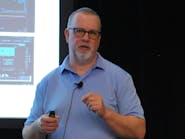OT visibility tool slashes waste for Thermo Fisher Scientific
High-tech digital tools can peer deep within operations and uncover hidden problems—such as people not filling out their freaking paperwork.
“‘Forms not ready’ accounted for five hours of downtime. It’s a form right? Why are we having an issue where forms aren’t ready?” asked Matt Wessel, senior data scientist at contract pharmaceutical manufacturer ThermoFisher Scientific.
Speaking at Automation Fair this week in Chicago, Wessel and Rockwell Automation’s Industry Data Solutions Lead Venkat Gopikanth discussed the dSME (digital subject matter expert) tool that the companies developed together. While it does many things, at its core, dSME captures operations technology (OT) data by logging various steps in the drug manufacturing process.
It gives managers near-real-time data (within about 10 minutes) of which machines are running, where they are in their processes, how much time is left to meet production schedules for the day and other information.
Gipokanth said the tool lays “the foundation for a continuous improvement process where time is essentially the currency of the production line. [The tool can] track production losses because of downtimes or changeovers, and then do a detailed root-cause analysis.”
As Wessel described it, the tool has given management a clear window into why some shifts are hitting targets and others are not.
Slowdowns due to fixable mistakes
Drug production is a highly regulated business, something that makes it a bit tougher to adjust operations throughout the day. If the Food & Drug Administration has approved a production rate for a drug, producers can’t go over that rate to catch up if they run into problems early in production. Wessel said those conditions mean the company absolutely needs to track everything that takes production time to discover where losses are.
In the case of the forms, he said one plant was effectively losing the ability to finish a full batch of drugs per week because forms weren’t ready. There were similar losses from people prepping the wrong equipment or making other mistakes that had nothing to do with the tough regulatory market—fixable mistakes, well within the company’s control.
However, before the tool, no one was tracking or quantifying some of those little things. No one realized the cumulative losses created by something as simple as poor paperwork hygiene.
“You start to see these similarities in these patterns that we’ve enabled because we’re giving the operators the ability to interact with the tool and enter their information,” Wessel said. “That is very powerful from an efficiency perspective, and again, scalable.”
The key was designing a tool that measured the right things and provided critical data to the right people. Most of the steps in the drug lines that it wanted monitored were automated, Wessel said. But a few weren’t.
That left his team with a few choices. Many programmers would add a compliance stage—employees must click a button to say when a process is finished to it can be logged in the system. Wessel said that’s a problematic approach (he uses it in some cases where there is no other way to measure steps, but he avoids it whenever possible). Compliance can be spotty. People can forget to click the button or can click it very late, making the data unreliable.
With most processes, he added, you can get around that issue by mapping out the manual and automated tasks and using the automated ones to inform the manual ones. When employees switch from producing one drug to another, Step 1 of that process is typically manual. But, Step 2, cleaning and sanitizing the line before new materials begin flowing, is automated. Rather than measuring when an employee said they finished Step 1, the system measures when the automated Step 2 begins, effectively giving a time stamp for Step 1 as well.
That sort of system and process thinking avoids adding repetitive tasks for employees and improves data collection.
Wessel concluded with saying that the tool’s real value is identifying bottlenecks in the process. Constantly comparing process maps to actual production makes it very obvious where problems are before scrap and waste builds up.
“If you go over time, why did you go over time? That’s really what it’s for,” Wessel said.
About the Author
Robert Schoenberger
Engineering Design and Automation Group
Robert Schoenberger is vice president of content strategy for the Engineering Design and Automation group of EndeavorB2B.
